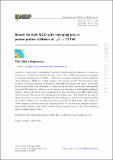Search for dark QCD with emerging jets in proton-proton collisions at √𝑠 = 13 TeV
Author(s)
Hayrapetyan, A.; Tumasyan, A.; Adam, W.; Andrejkovic, J. W.; Bergauer, T.; Chatterjee, S.; Damanakis, K.; Dragicevic, M.; Hussain, P. S.; Jeitler, M.; Krammer, N.; Li, A.; Liko, D.; Mikulec, I.; Schieck, J.; Schöfbeck, R.; ... Show more Show less
Download13130_2024_Article_23979.pdf (2.573Mb)
Publisher with Creative Commons License
Publisher with Creative Commons License
Creative Commons Attribution
Terms of use
Metadata
Show full item recordAbstract
A search for “emerging jets” produced in proton-proton collisions at a center-of-mass energy of 13 TeV is performed using data collected by the CMS experiment corresponding to an integrated luminosity of 138 fb−1. This search examines a hypothetical dark quantum chromodynamics (QCD) sector that couples to the standard model (SM) through a scalar mediator. The scalar mediator decays into an SM quark and a dark sector quark. As the dark sector quark showers and hadronizes, it produces long-lived dark mesons that subsequently decay into SM particles, resulting in a jet, known as an emerging jet, with multiple displaced vertices. This search looks for pair production of the scalar mediator at the LHC, which yields events with two SM jets and two emerging jets at leading order. The results are interpreted using two dark sector models with different flavor structures, and exclude mediator masses up to 1950 (1950) GeV for an unflavored (flavor-aligned) dark QCD model. The unflavored results surpass a previous search for emerging jets by setting the most stringent mediator mass exclusion limits to date, while the flavor-aligned results provide the first direct mediator mass exclusion limits to date.
Date issued
2024-07-16Department
Massachusetts Institute of Technology. Department of PhysicsJournal
Journal of High Energy Physics
Publisher
Springer Berlin Heidelberg
Citation
The CMS collaboration., Hayrapetyan, A., Tumasyan, A. et al. Search for dark QCD with emerging jets in proton-proton collisions at √𝑠 = 13 TeV. J. High Energ. Phys. 2024, 142 (2024).
Version: Final published version